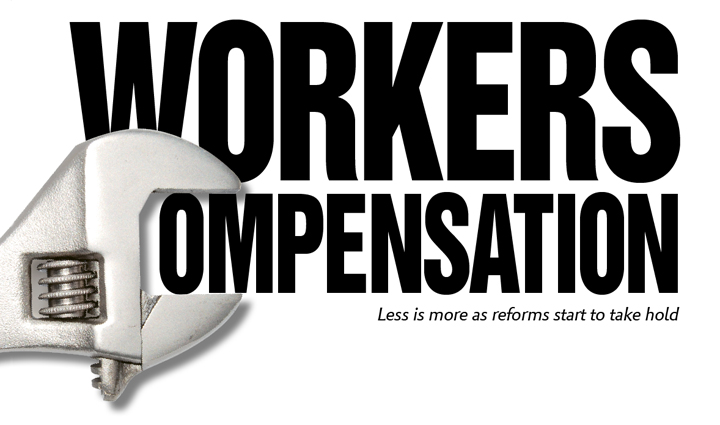Less is more as reforms start to take hold
Kathy Antonello had good news to report about workers compensation insurance in her “State of the Line” presentation at the recent Annual Issues Symposium of the National Council on Compensation Insurance (NCCI), the nation’s leading statistical and rating organization for workers comp.
Despite a small decline in workers comp premium from 2016 to 2017, Antonello, the NCCI’s chief actuary, could point to a five-percentage point improvement in the line’s calendar year combined ratio, from 94 to 89, the lowest reported in more than 20 years and well below the property/casualty industry’s 2017 combined ratio of 104.
Thanks to increased payroll (the principal workers comp rating base), improved investment returns (although still below average), a reduction in lost-time claim frequency, and only moderate increases in claim severity, workers comp carriers were able to add to their surplus and strengthen their reserve positions, despite the decline in premium.
One effect from the strong operating results is a reduction in rates, as Antonello reported a 5.4% drop in approved premium levels in 2017, the biggest decline in at least 15 years. NCCI projects a nearly 10% reduction for 2018. (Premium level changes reflect approved changes to advisory rates, loss costs, assigned risk rates, and rating values.)
Overall industry experience and individual carrier experience have been strong for the past few years and rates are coming down across the country. This is a challenge for carriers trying to balance rate adequacy and profit goals.”
—Andy Feuker
Director of Workers Compensation and Commercial Umbrella
Utica National Insurance Group
There will be political pressure for even greater rate reductions. At the end of May 2018, California Insurance Commissioner Dave Jones issued a workers compensation advisory pure premium rate of $1.74 per $100 of payroll, below the average recommended by the state’s Workers’ Compensation Bureau and down 36.5% since January 2015.
The rate is only advisory, but Jones exhorts insurers to “do the right thing and pass along more cost savings to California employers.”
All this is all good news for employers purchasing coverage, but not necessarily for those trying to sell it.
“The current market is competitive and softening,” says Andy Feuker, director of workers compensation and commercial umbrellas for Utica National Insurance Group. “Overall industry experience and individual carrier experience have been strong for the past few years and rates are coming down across the country. This is a challenge for carriers trying to balance rate adequacy and profit goals.”
“The market for workers compensation continues to be competitive, unless you are a specialist,” says Danny Ramsey, commercial lines product development manager at Westfield Insurance. “Because of that fact, there is still pressure on price.”
Impact of reform
Among other things, the recent profitability of workers comp almost certainly reflects reforms implemented in several state workers comp systems.
In a series of reports for individual states published in 2018, the Workers Compensation Research Institute (WCRI) found that states that have enacted reforms to their workers compensation systems have seen a slowing of or reduction in average costs per claim.
For example, California, which enacted reforms in 2013, has since seen 2% to 5% annual decreases in the cost of medical payments. Similarly, Indiana, saw medical payments stabilize after enacting reforms in 2014, following nine years of 7% to 8% increases.
Feuker wonders, however, if anticipation of the impact of the reforms may be premature.
“The medical cost reforms should have a positive impact on the industry loss ratio over the next 12 to 24 months,” he says. “However, these changes have not yet had a tangible impact on overall operating results. There were recent reforms in New York that will impact our largest book of business, but we don’t know what the net impact will be.”
In the meantime, Feuker says that “ratemaking bodies are putting a large amount of faith in the projected savings from these reforms and providing downward loss cost guidance. The accuracy of these projections will be a determining factor of profitability.”
Medical advances
There’s no question about the immediate impact of recent medical advances on workers comp insurance.
“These are exciting times in workers compensation,” says Jim Bowers, Westfield’s claim process leader for the line. “Advances in surgical techniques, medical equipment, and pharmaceuticals speed recoveries and promote better outcomes.”
“Telemedicine” and “nurse triage services” are among the new capabilities that Westfield utilizes to shorten recoveries and control costs, according to Bowers. “Medical inflation continues in workers compensation,” he notes, “but our approach has resulted in favorable loss and combined ratio trends over the last six years.”
These are exciting times in workers compensation. Advances in surgical techniques, medical equipment, and pharmaceuticals speed recoveries and promote better outcomes.”
—Jim Bowers
Claims Process Leader
Westfield Insurance
While annual increases in workers comp medical claims severity have slowed, they are still greater than increases in the consumer price index for medical services, according to Robert Hartwig, a professor of insurance and risk management at the University of South Carolina, in his presentation to the NCCI symposium.
“Despite recently passed medical reforms, we are still seeing a trending upward in medical severity,” says Feuker. “Major medical procedures including, but not limited to, surgery continue to drive the year-over-year medical costs.”
Size matters
In a market with soft prices and regulated products, loss control and claims become defining features of a carrier’s competitiveness.
“Large employers will continue to have available markets because of their willingness to assume or retain more risk,” says Ramsey. “Large companies know the value of managing their claims and controlling sources of loss, and they fully embrace the services offered by insurers.”
On the other hand, he says, some smaller businesses can be too price-conscious and may overlook the long-term benefits of managing and controlling losses.
For producers, he adds, “The key to marketing workers comp coverage is to have better alignment with clients on their needs.
“It’s about more than just rates and price,” he notes. “It’s about the total cost for the client. Marketing strategies that focus on controlling costs educate customers about the long-term benefits of managing and controlling the things that matter to them.”
“When coverages don’t vary much from carrier to carrier due to statute, an insurer’s claim performance can vary greatly based on the proficiency of their claims professionals,” says Feuker.
“Our claims operation helps contain costs while getting injured workers back on the job as soon as possible,” he says. “We understand that getting back to ‘business as usual’ is important to our policyholders.”
The American economy is getting back to business as usual, according to Hartwig, as it has seen vigorous growth in jobs and hours worked, and slow but steady growth in wages, driven in part by statutory increases in the minimum wage in numerous states.
Those factors, along with a boost from the 2017 federal tax law, will benefit prop- erty and casualty insurers in general, and workers comp carriers in particular, he told his NCCI audience. They provide welcome support as investment yields, although improving, still hover at levels not seen since the mid-1960s.
Hartwig noted that big questions remain for the line as in the uncertainties regarding healthcare financing, which could result in cost-shifting to workers comp, and trade policy, which could disrupt employment in certain sectors.
For more information:
National Council on Compensation Insurance
www.ncci.com
Utica National Insurance Group
www.uticanational.com
Westfield Insurance
www.westfieldinsurance.com
The author
Joseph S. Harrington, CPCU, is an independent business writer specializing in property and casualty insurance coverages and operations. For 21 years, Joe was the communications director for the American Association of Insurance Services (AAIS), a P-C advisory organization. Prior to that, Joe worked in journalism and as a reporter and editor in financial services.






